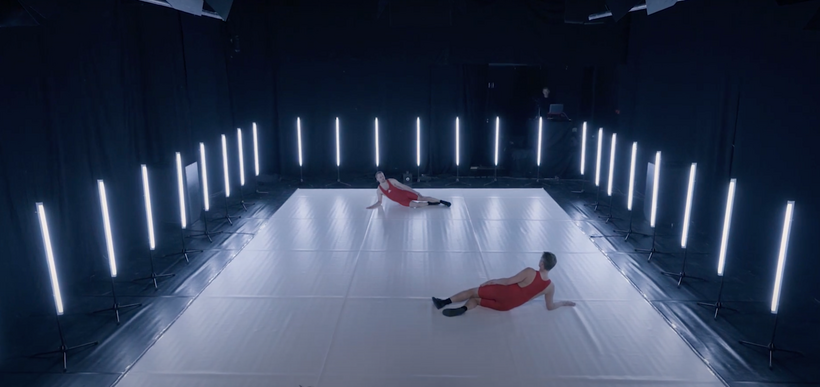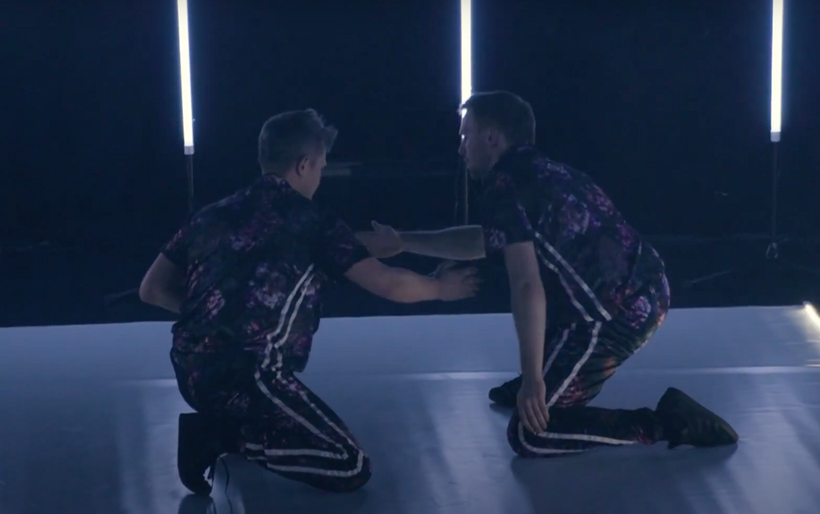What are hybrids for? Choreographic language between stage and screen
Interpreting art in novel styles and forms is a delicate matter – almost as delicate as creating it. When film began to earn its status as an autonomous art form, critics emphasised its difference with theatre and its ability to do what the latter could not, mirroring more recent approaches to screendance: Does the camera add anything at all? Or does it distract, distort, or even subtract from conventional performances?
These questions map onto particular works as ways of justifying an alien landscape, how and why content merits its as-yet-unfamiliar form. And the task of the critic, in the words of Umberto Eco, is to keep asking “why there is Being rather than Nothing”; spinning out a theodicy for the creator’s heterocosm. As filmmakers expanded the range of techniques deployed to represent narrative content, the language of film started to expand, giving rise to critical vindications, conventional standards, and a variety of associated genres, types of work, and schools of thought. Hitchcock’s camerawork was seen to capture relevant aspects of plot and content, contributing to his landmark build-up of suspense, or metaphorically conveying the complex relationships between his characters in ways that theatre could not. Something similar occurred when French auteurs began challenging the rules of Hollywood films, popularising their non-linear narratives, fragmented editing, and a marked documentary style to capture their characters’ subjectivity as “realistically” as possible. A new vocabulary emerged organically, representing a fictional narrative that shifted between subjective and objective viewpoints. While this had been done in photography, documentaries, and commercial films, it served to hive off film from theatre – two art forms capable of representing similar content, but using different vocabularies suited to their media.
Contemporary dance, on the other hand, is often more focused on conceptual impressions than it is on narrative. According to Noël Carroll, something counts as dance if it is drawn from an existing dance vocabulary, and is therefore recognisable as such by some shared standard. When this rather abstract vocabulary defies convention, we are forced to summon meanings gathered from elsewhere – films, theatre, or even everyday notions – in order to read the intentions of our pseudo-divine creator. And if the force and intelligibility of choreographic vocabulary is granted by moving bodies, action patterns, and non-verbal representation, borrowing signifiers from different visual and performing arts risks obscuring the expressive subtleties that have secured dance’s position as an autonomous art form. What follows is an example of how, in hybrids between film and dance, appreciating the specific contribution of filmic vocabulary can change the reading and evaluation of a given piece, where substance and a hint of narrative are smuggled into choreography through conscientious camerawork.
Mixed vocabularies in Geyr Hytten’s Hello brother
The notion of a dance vocabulary helps us understand Carroll’s classification of the three species that fall within a moving picture dance, depending on which is working at the service of the other.
The first is that of dance documentations, mainly aimed to record individual performances through various technological media. The second, dance reconstructions, are those showing the audience “how and where to look at a preexisting dance, and how to organize the dance and its important patterns in their temporal experience” (Carroll 2001, 56). One example is the film “Black and White Ballets”, directed by Hans Hulscher, which brings together six performances choreographed by Jiri Kylián between 1986 and 1991. While Kylián himself never conceived them as a series, Hulscher uses a homogenous set-up to emphasise the similarities at this stage of Kylián’s artistic development, now widely acknowledged between critics and audiences: a minimalistic stage design, a black edge from which dancers emerge and disappear, and effective lighting suited to the moving-picture format to hide and reveal body parts and facial expressions. This has generated a whole literature of interpretations of the six original performances, picking up on the themes of sexuality, politics, and the use of irregular rhythms in music and body percussion as common denominators of all six performances. As Carroll notes, dance reconstructions such as “Black and White Ballets” thus aim to make pre-existing performances “accessible visually (and aurally)” to audiences through an interpretation of them, adapted to the medium of film (ibid). In the case of dance reconstructions, the justification of film media lies between the practicality of dance documentations and that of an interpretive tool for deciphering choreographic vocabulary. Lastly, when the driving vocabulary is not that of dance, but that of film, we get what Carroll coins a dance construction, where the motion picture “calls the tune” (54), and the piece is primarily conceived for recording as a film. The concept of dance constructions brings out an important point about how we look at hybrid pieces that share the same media: the language of the camera in a dance reconstruction is not the same as the language of camerawork in dance constructions, where we are required to read the piece together with a notion of filmic or theatrical works, and a background in their specific vocabularies.
Geyr Hytten’s film version of hello brother adapts an original work, meant for performance in a stage re-creation of a wrestling ring, into a moving-picture dance filmed in the woods. The force of Hytten as a choreographer, and of Antero Hein as a director, hangs on the language in which we interpret the 2020 piece as a moving picture dance: whether it is a construction or a reconstruction of the previous work. On the one hand, choreography seems to add little to the concept of nature as a driving force in the piece. Still clad in their Adidas jumpsuits, the two dancers trot and crawl across the wilderness, accompanied by an unnerving, almost cinematic soundscape. The only way in which they interact with nature is by tearing the trees from the ground and crouching like animals, mirroring each other’s movement detachedly. But what, if anything, does the new setting add to the initial piece, which was supposed to reflect on neoliberalism and human relationships? Easily enough, we may read the film version of hello brother as a representation of humanity (or human maleness, in particular) as a destructive force, but this is an image we are far too familiar with – as consumers of culture, and as political subjects. If Hytten’s world is just his critical take on our own, then he says nothing new, and merely transplants the two original wrestlers into the forest, reversing the timeline from modern societies back to the pre-industrial world.
The picture changes somewhat only if we read the piece in the language it was rewritten: a filmmaker’s language. If camerawork is able to do anything with dance other than help change the setting, it is to capture human interactions as though they were non-human, that is, give us quite literally a bird’s eye view on our own madness. In this context, what merits vindication is not a representation of industrial brutality, but what it could look like when viewed from a non-human standpoint.
Can dance speak like film? Should it?
Without appealing to the original performance of hello brother, I have suggested that choreography alone does not serve to shed the illuminating perspective on nature and neoliberalism that is explicitly intended by the film. Let me, therefore, describe a way in which this work is actually performed by the camerawork, chiming with more conventional vocabularies from classic cinema, which literally change our perspective on the content represented – as well as its social and affective implications.
In Wim Wenders’ Wings of Desire, two atemporal guardian angels look upon the human world without the ability to engage in it, and have borne witness to the whole of history from above. Henri Alekan’s aerial camerawork efficiently captures their perspective, and brings it back to more conventional ground-level tracking shots as its main character – a fallen guardian angel – takes human form, and learns to experience the mortal world he thought he knew. Clad in rather inappropriate clothing, he struggles to blend in with post-war Berlin, and is struck by the new experience of human relationships his human condition affords him. In the dance film hello brother, red wrestling jumpsuits are deliberate, and not just a reference to the 2019 performance. In fact, the music – which feels rather like a soundtrack – is strongly evocative of fantasy or sci-fi film openings, suggesting that we have been introduced into a universe different from our own. The sense of estrangement is emphasised by choreographic subtleties, with the dancers advancing in an almost mechanical, robotic fashion, evoking a glitch on a digital video screen.
In this regard, both Wenders and Hein’s camerawork, music, and wardrobe choices symbolise and demonstrate their main characters’ maladaptive behaviour in the world they come to inhabit, as they are forced down to an unfamiliar world. But deep down, both films show – and don’t tell – that it isn’t their behaviour that is maladaptive, but our own: for Wenders, ceaseless war and human violence; for Hytten, the destruction of an environment that used to be our spiritual and physical home. While these messages are undeniably familiar, the movement of the camera and the “othering” of quasi-human characters (the two dancers, and the guardian angels) show how our own society might be viewed and frowned upon by an external observer who hasn’t yet internalised human history as a natural turn of events.
As a dance reconstruction, the film hello brother is metaphor of our own world, but one where the relations between humans, nature, and neoliberalism are only recognisable through poor and hackneyed symbolism: the industrial apparel, the exuberant ecosystem, the detached deforestation. Putting the original work aside, we can allow ourselves to be guided by the camera’s shift of perspective onto our own relation to nature, estranging it, making it alien enough to replicate the viewpoint of an external observer – like that of Wenders’ angels. Going back to Eco’s cosmological metaphor: what has been justified is not the world represented in Hytten’s film – in last instance, a satire or metaphor of our own – but the way in which the camera captures it. We are now invisible voyeurs of a parallel reality, rethinking our own relation to the natural environment through the only appropriate vocabulary: foreign, unnatural, and ultimately inhumane.
Review written during the workshop Writing about dance (in the Times of Corona), organised by Dance and Performing Arts Criticism in Europe, supported by EEA Grants 2014-2021.
hello brother
Concept/Choreography/Dance: Geir Hytten
Dance: Stian Vikjord Danielsen
Music: Sjur Miljeteig
Scenography/Light/ Costume: Corentin Jean-Paul Marcel Leven
Outside eye: Terje Mossige
Co-producer: DansiT
References:
Carroll, Noël. “Toward a Definition of Moving-Picture Dance.” In Dance Research Journal, vol. 33, no. 1, 2001, pp. 46–61. <i>JSTOR</i>, www.jstor.org/stable/1478856. Accessed 19 Aug. 2021.
Eco, Umberto. Sei passeggiate nei boschi narrativi. Bompiani, 2000.





